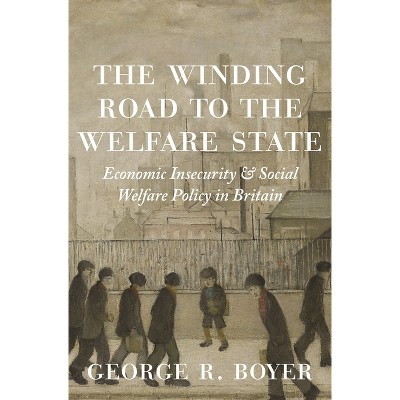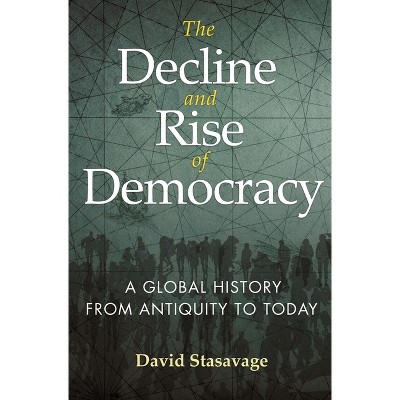Sponsored

The Hidden Victims - (Princeton Economic History of the Western World) by Cormac Ó Gráda (Hardcover)
$60.00
In Stock
Eligible for registries and wish lists
Sponsored
About this item
Highlights
- A staggering new account of the civilian death toll of the world wars--and what it reveals about the true nature and cost of modern war Soldiers have never been the only casualties of wars.
- About the Author: Cormac Ó Gráda is an Irish economic historian and professor emeritus at University College Dublin.
- 520 Pages
- History, Military
- Series Name: Princeton Economic History of the Western World
Description
About the Book
"The two world wars were undoubtedly two of the most catastrophic events in human history, not just for those who actually fought in them, but for untold millions of civilians. And even though the wars' superlativeness is unquestioned, our understanding of exactly how bad the civilian costs were is limited. Although the numbers are better for the two wars than for most earlier wars, gaps and uncertainties remain. States went to great lengths to record military casualties, but civilian fatalities often went uncounted, and figures were often deliberately obscured. In this book, renowned economic historian Cormac O Grada aims to set the record straight, establishing a figure for civilian fatalities that reveals much about the nature of modern war. The book builds on earlier estimates of casualties from a range of causes, some reliable, some approximate at best, and warns against spurious precision when approximations are impossible. For example, while the human toll of the Jewish Holocaust is generally agreed to have been about 6 million, the tolls of two other war genocides, those of the Armenian community in Turkey during World War I and of the European Roma community during World War II, cannot be determined with any precision. (Scholarly estimates of these range from 0.6 to 1.2 million, and from "at least 130,000" to "between 250,000 and 500,000.") During World War II Chinese civilians faced both a civil war and Japanese occupation, and no estimate of the resulting civilian deaths, which range from an implausibly low 2.5 million to 20 million, is reliable. The book shows that the single biggest cause of civilian deaths during the two wars were famines, some of which are familiar and well-documented, while others have attracted research only recently, and a few await systematic analysis. The book covers these as well as genocides, particularly the Jewish Holocaust, and deaths from aerial bombing, and shows how in each of these categories the numbers have been controversial and contested. Most of the book deals with death, but it contains accounts too of the tens of millions of displaced persons and refugees and forced labourers, of civilian trauma, and of sexual violence and other atrocities. In the end O Grada argues that the two world wars cost at least 45 to 50 million civilian lives, almost double the cost in military lives. Addressing the uncertainties and inaccuracies in civilian casualties, the book shows the failings of international law and gives a vital and harrowing understanding of the true cost of war"--Book Synopsis
A staggering new account of the civilian death toll of the world wars--and what it reveals about the true nature and cost of modern war
Soldiers have never been the only casualties of wars. But the armies that fought World Wars I and II killed far more civilians than soldiers as they countenanced or deliberately inflicted civilian deaths on a mass scale. By one reputable estimate, 9.7 million civilians and 9 million combatants died in World War I, while World War II killed 25.5 million civilians and 15 million combatants. But in The Hidden Victims, Cormac Ó Gráda argues that even these shocking numbers are almost certainly too low. Carefully evaluating all the evidence available, he estimates that the wars cost not 35 million but some 65 million civilian lives--nearly two-thirds of the 100 million total killed. Indeed, he shows that war-induced famines alone may have killed 30 million people, making them the single largest cause of death. The Hidden Victims is the first book to attempt to measure and describe the full scale of civilian deaths during the world wars, from all causes, including genocide, starvation, aerial bombardment, and disease. While nations went to great lengths to record military casualties, they often didn't count or deliberately obscured civilian deaths. Getting the numbers right is important. It reveals much about the true human costs of the wars, the nature of modern warfare, and the failure of efforts to stop civilian casualties. It also makes it possible to argue with those who try to deny, minimize, or exaggerate wartime savagery.Review Quotes
"The Hidden Victims: Civilian Casualties of the Two World Wars is an ambitious book that enumerates civilian suffering across the era of the world wars. It is engagingly written, accessible, and holds the reader's interest as it traverses this world of war, narrating the horrors inflicted both 'accidentally' and 'deliberately' on civilians. . . . There are so few one-volume histories that connect the two world wars in meaningful ways. Cormac Ó Gráda thus deserves high praise."---Maartje Abbenhuis, Diplomatic History
"[The Hidden Victims] a recommended reading for anyone interested in the fate of civilians during the two world wars. Hopefully, this book will motivate scholars to reevaluate our understanding of victims in all armed conflicts: the short and longterm impacts of wars on populations and the response of societies facing death, violence and atrocities against individuals who are not responsible for wars. An understanding still important today."---Jean-Michel Turcotte, Canadian Military History
"[The Hidden Victims] is a valuable book for scholars of the World Wars who take the time and effort to immerse themselves in this study. . . . Highly recommended."-- "Choice"
"A timely publication. . . . Ó Gráda's formidable talent as an economic historian brings us an extremely valuable and accessible work which is about more than numbers for the sake of numbers."---Laurence Marley, The Irish Times
"A work of great moral as well as of historical importance. One of Ireland's greatest historians scrupulously sifts the evidence from the first and second World Wars and their 'collateral damage' of genocide, famine, aerial bombing and disease. . . .The resonances for the present are profound: this book is a potent warning against amnesia and evasion."---Fintan O'Toole, Irish Times
"First-rate. . . . This important book will make my best non-fiction of the year list."---Tyler Cowen, Marginal Revolution
About the Author
Cormac Ó Gráda is an Irish economic historian and professor emeritus at University College Dublin. His many books include Famine: A Short History and Black '47 and Beyond: The Great Irish Famine in History, Economy, and Memory (both Princeton).Dimensions (Overall): 9.3 Inches (H) x 6.3 Inches (W) x 1.5 Inches (D)
Weight: 2.0 Pounds
Suggested Age: 22 Years and Up
Series Title: Princeton Economic History of the Western World
Sub-Genre: Military
Genre: History
Number of Pages: 520
Publisher: Princeton University Press
Theme: World War I
Format: Hardcover
Author: Cormac Ó Gráda
Language: English
Street Date: September 3, 2024
TCIN: 91111636
UPC: 9780691258751
Item Number (DPCI): 247-39-2476
Origin: Made in the USA or Imported
If the item details aren’t accurate or complete, we want to know about it.
Shipping details
Estimated ship dimensions: 1.5 inches length x 6.3 inches width x 9.3 inches height
Estimated ship weight: 2 pounds
We regret that this item cannot be shipped to PO Boxes.
This item cannot be shipped to the following locations: American Samoa (see also separate entry under AS), Guam (see also separate entry under GU), Northern Mariana Islands, Puerto Rico (see also separate entry under PR), United States Minor Outlying Islands, Virgin Islands, U.S., APO/FPO
Return details
This item can be returned to any Target store or Target.com.
This item must be returned within 90 days of the date it was purchased in store, shipped, delivered by a Shipt shopper, or made ready for pickup.
See the return policy for complete information.
Trending Non-Fiction


$19.58
MSRP $29.00
Buy 2, get 1 free select books
4.7 out of 5 stars with 11 ratings

$4.59
MSRP $7.99
Buy 2, get 1 free select books
4.8 out of 5 stars with 116 ratings

$6.20
MSRP $10.95
Buy 2, get 1 free select books
4.8 out of 5 stars with 32 ratings

$7.09
MSRP $9.99
Buy 2, get 1 free select books
4.9 out of 5 stars with 45 ratings

$10.84
MSRP $15.99
Buy 2, get 1 free select books
4.6 out of 5 stars with 33 ratings





